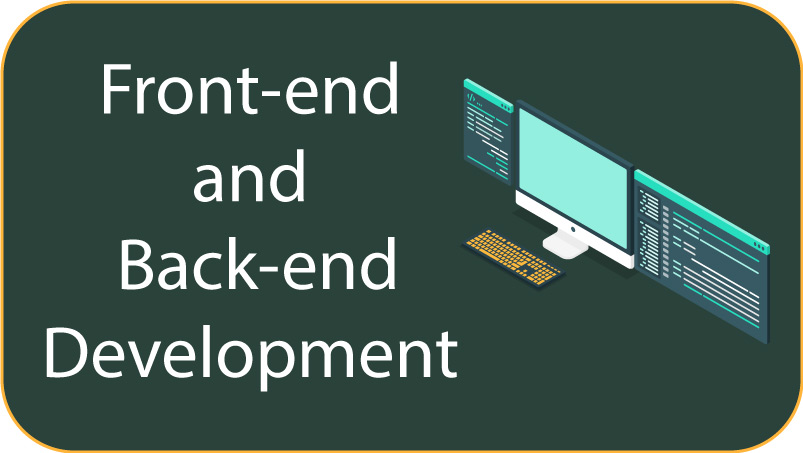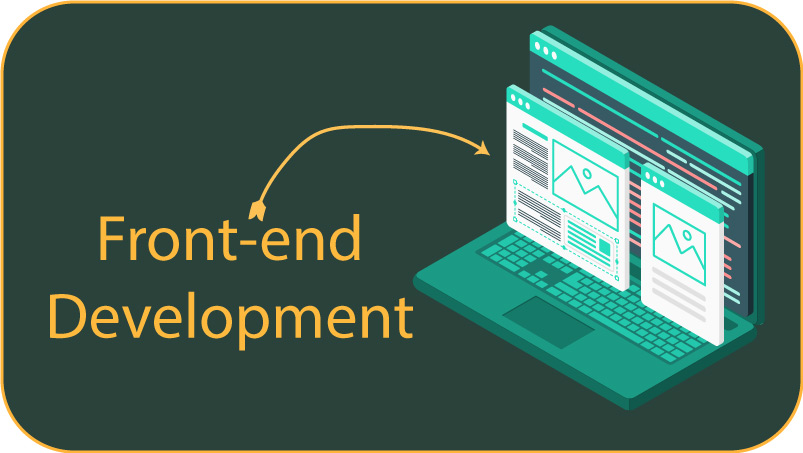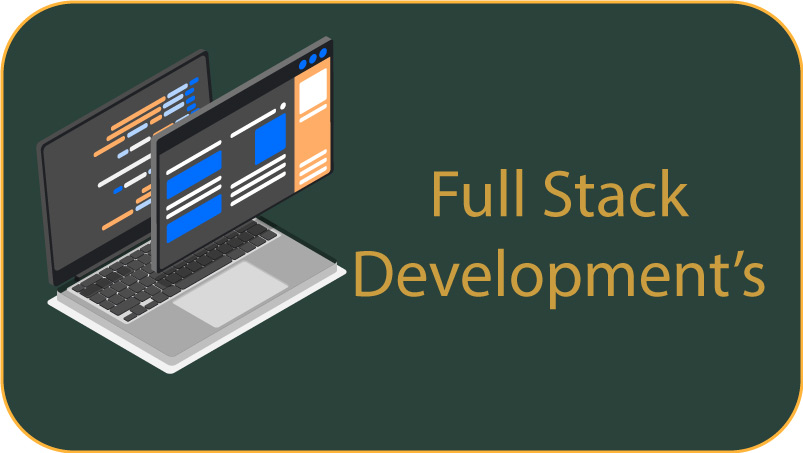Navigating the Future: Key Industry Trends Shaping Digital Marketing
In the fast-paced world of digital marketing, staying ahead of the curve is essential for businesses and marketer

Meta Description: Learn the differences, career paths, salaries and technology trends to choose between front-end and back-end development. Read on to learn more!

Web development is full of lively discussions, particularly around front end and back end roles. Each has a special part to play in creating a top-notch site. They have different tasks, though. Picture a front end developer as an artist bringing the site to life visually for users. Imagine a back end developer as the wizard who makes sure everything works smoothly out of sight.
Both paths have their own sets of rewards and hurdles. We’re jumping into the heated front end versus back end debate. Expect a clear breakdown of each role’s pluses and minuses to help you see where you might fit best.
Back end development focuses on what happens behind the curtain. The back end is where developers build the core parts that keep a website running. This includes the server, database, and applications. Back end devs use languages like PHP, Python, Ruby, or Java.
Their tasks? They handle data, make sure everything on the server side works right, and keep it all connected with other tech. A big part of their job is to ensure the website runs smoothly and stays secure, especially when lots of people visit at once.
So, front end development shapes how a website looks and feels. Back end development, though, keeps everything working under the hood. Both roles are key to creating a great website. Some developers focus on just one, but others learn both and become full stack developers. This means they can handle both the visuals and the tech that powers a site.
We’ll look at what skills you need for front end and back end development. You’ll see the job possibilities and pay for each. This will help you to pick the right career path. Let’s get into the front end vs back end discussion!
Different skills suit front end and back end work. Knowing which fits you is key before you choose your path.
For front end developers, it’s crucial to know HTML, CSS, and JavaScript well. These coding languages make websites look good and work smoothly. Front end developers must also get responsive design right. This makes sure sites work on various gadgets and screens. Being good at using tools like React or Angular is also a big plus.
Back end developers should be skilled in server-side languages such as PHP, Python, Ruby, or Java. Understanding databases and SQL is essential for them because they handle and change data.
These developers must also be versed in server management and deployment. They should know about security measures and good practices. Front end and back end developers alike need to solve problems well. They think sharply.
They must figure out and fix problems. It’s important to stay up-to-date with tech changes and industry moves. Being able to talk well and work with others matters too, as teamwork is common and ideas must be shared clearly.
While front end and back end developers have different skill sets, both types need a mix of tech knowledge and people skills. Consider your abilities and what you like to decide which development path suits you.
Thinking about a web development career? It’s essential to weigh the futures and earnings of different paths. We’ll look at the career chances and pay for front end and back end developers.
Front end and back end developers are both in demand. Companies want to grow online, so they need developers. Front end devs get to work with designers, making beautiful sites. Back end devs tough it out behind the scenes. They make sure websites work well, even with lots of users and data.
As for money, both front end and back end developers can make good salaries. But, back end devs usually make a bit more, thanks to needing extra tech knowledge. Remember, though, what you make can change with your experience level, where you are, and the company’s size.
In the end, choosing between front end and back end depends on what you like and where you want to go. Both offer great job chances and pay. Think about what you’re good at and what excites you to pick your path.

Front-end web development is booming. Companies seek web developers to expand online. This demand breeds promising opportunities. Here’s why businesses seek front-end devs:
💡 Key Takeaway: Front-end development is a solid career choice. It’s all about the latest web tech, making sites work on phones, growing e-commerce, and working well with others.
You know the basics of front and back end development, the skills needed, and how these jobs pay. What’s next? Which path is yours?
The choice might seem tough. Both roles come with their own set of rewards and challenges. It’s all about what you’re into, your talents, and where you see yourself in the future.
Love design? Enjoy making sites look good? Front end might be your thing. Front end devs team up with designers to shape a site’s style. Your job is to make sure the site grabs users’ attention and is a breeze to use.
If you like solving puzzles and enjoy diving into data, back end development might be your thing. Back end devs handle the heavy coding that keeps sites running. They ensure data is safe, servers are speedy, and that everything works like it should. The focus? Making sure the website functions smoothly.
On the horizon, there’s full stack development, too. These tech pros know both the front and back end. They tackle a project from top to bottom. Being a full stack developer means you have more tools in your kit. It opens doors to diverse job prospects since you’re versatile.
Your choice between front end and back end should reflect what you love. Ask yourself: What am I good at? What brings me joy? Each path in web development is filled with opportunities. Whether you go front, back, or full stack, you’re stepping into a lively and dynamic field.

These days, companies want developers who can do it all. That’s why full stack development is getting popular. A full stack developer has the skills for both front end and back end work, which is why they are in demand. Employers like how they make the team more efficient.
Full stack development is booming for a few reasons. Companies want one person who can handle every part of a site, from how it looks to the servers behind it.
This is good for teams. When full stack developers are on board, everyone works better together. They get what both sides of the website building process need.
Full stack development expands a programmer’s abilities and opens up more job paths. When you learn both client-side and server-side tech, you become flexible enough to tackle varied projects in web development. This not only boosts your career growth but also preps you for fast-moving tech trends.
Also, full stack devs can drive innovation. Knowing how to mesh the look with the mechanics of a site, they build efficient, engaging online spaces. Today’s users get websites that really work for them.
But remember, the path to full stack expertise is tough. It’s a field that moves quick, and keeping sharp means brushing up on the newest in both front and back end tools. You’ve got to commit to learning, non-stop, to stay in the game.
Web designers are always looking ahead. They’re trying to guess what’s next for making websites as new tools and ideas pop up. Front end creators, who make the site look good, and back end architects, who build the unseen parts, will both change a lot because tech keeps zooming ahead.
For the front end folks, making sites easy and fun to use is becoming more important. They’ll have to know the newest ways to design cool websites that work great on phones and other gadgets. They’re even starting to use some really fancy tech like VR and talking interfaces to make cooler websites.
Looking ahead, the field of back end development will be shaped by a growing need for systems that can scale, are secure, and manage data well. More data and more users mean developers must get good at using tools like the cloud, services broken into smaller parts, and data analysis to keep everything running smoothly.
Also, the push for developers who understand both front and back end — the full stack developers — is getting stronger. Companies want these versatile experts more and more. This shift means developers should learn to juggle various technologies and switch gears when needed.

Are you thinking about a career in coding? You might be asking, “Should I go for front end or back end work for better job chances?” It’s a great question. Here, we look at what’s in demand: front end or back end coding.
Truth is, the tech world really needs both front end and back end coders. Companies keep growing their web stuff. They need coders who can make cool stuff for users and also coders who can make sure everything works well and stays safe behind the scenes.
Front end and back end developers are both crucial and in demand. The secret to thriving in this field? Balance. Match your talents, passions, and career aspirations with the right development path. Which path you walk — front end, back end, or the full stack trail—leads to a host of enticing web development adventures.
Both front end and back end realms are transformed by tech progress. This change molds how websites and apps come to life and how users interact with them. Devs face diverse hurdles and chances due to the constant tech shifts.
On the front end, there’s a push for web spaces that react and interact smoothly. Browser upgrades, the surge in mobile use, and user demand shape this. Front end pros tweak their craft to polish sites across many devices. Techniques in responsive design grow, and so does the use of frameworks like Bootstrap and Foundation.
New JavaScript tools like React and Vue.js let front end devs make cool, interactive sites. On the back end, folks work on making sites that can handle more visitors without breaking a sweat, keeping things safe and snappy. They’re also getting really good at using cloud tech and breaking up apps into bite-size services. Plus, new database tech helps them juggle tons of info really well.
Technology keeps growing quickly. It means web designers and coders must always be learning. They need to keep up with new trends and smart ways of doing things. This field changes fast. Good developers are ready to pick up new skills. They use new tools to make websites work well and look great for users.
Creating an awesome website demands that front end and back end developers work in harmony. They need to merge their skills perfectly. This unity is key to a site that’s not only eye-catching but also works like a charm.
A front end developer must get the hang of back end stuff. Knowing this helps them team up with back end developers well. This knowledge lets them make sure their cool designs actually work with the back end systems. When they team up right, the build process goes smoothly, leading to a website that wows visitors and runs without a hitch.
Back end developers need to know front end concepts too. They use this knowledge to make sure the site works well and keeps information safe. By understanding the front end, they make sure the two parts of the site work together smoothly.
Being good at both back end and front end means talking well with others. Front end and back end developers must team up. They discuss what the site should do and look like. This teamwork helps make the site easy and nice for people to use.
Good teamwork between front end and back end developers is key for a top-notch website. Front end pros make sites look good and easy to use. Back end pros work on the site’s engine—like how it saves data and runs smoothly. They need to work in harmony to make a site that’s as nice to look at as it is efficient.
Great teaming up starts with everyone talking and understanding the plan. Front end folks should tell back end buddies what the site should feel like for users. In turn, back end experts need to explain what can and can’t be done technically. Putting their heads together often keeps both sides in sync, building a site that rocks.
When teams join forces, they spark more creativity and find newer, better ways to do things. Say front end and back end developers team up—they can think up cool features that make websites easier to use and look awesome. Like, front end pros might pitch ideas for fun, clickable stuff, and the back end folks can make sure everything runs smooth in the background.
Plus, when these two squads talk and share what they know, they can spot problems super early. They look at the website from all angles, catch tricky tech snags, slow spots, or security stuff that could trip us up later. Fixing things fast means the whole website-making goes like a dream.
So, having the front end and back end people work together is like a secret ingredient for an epic website. They mix up their skills to build sites that aren’t just easy on the eyes but also work like a charm, quick and with no fuss, for everyone.
Based on the current demand and career prospects in the tech industry, both front-end and back-end development paths are in high demand. Front-end development focuses on the user interface and user experience, encompassing technologies such as HTML, CSS, and JavaScript. With the rapid growth of web and mobile applications, skilled front-end developers are sought-after to create visually appealing and interactive user interfaces.
On the other hand, back-end development deals with the server-side of applications, handling databases, security, and performance optimizations. It involves technologies like PHP, Python, Java, and databases like MySQL or MongoDB. As businesses increasingly rely on complex data processing and server management, the demand for skilled back-end developers continues to rise.
Front-end development focuses on the user-facing aspects of a website or application. It involves creating and implementing the visual and interactive elements that users see and interact with. Front-end developers primarily work with HTML, CSS, and JavaScript to build the user interface and ensure a smooth user experience.
While front-end development focuses on the user interface, back-end development deals with behind-the-scenes functionality. Back-end developers build the server-side and database components that power websites and applications. They work with languages like Python, PHP, Ruby, or Java to handle data processing, server management, and the business logic of an application.
Companies want great websites and apps. Front-end pros make this happen with their design skills. More companies mean more jobs for these tech experts. Front-end developers are everywhere – tech firms, big companies, even small startups. Stay sharp with new skills, and you’ll go far. Big chance for a stable, long-term tech career here.
Our blog is a hub for valuable resources, informative guides, and insightful commentary on a
variety of industry topics, designed to help you stay up-to-date and informed.
In the fast-paced world of digital marketing, staying ahead of the curve is essential for businesses and marketer
In the fast-paced and ever-evolving world of digital marketing, staying informed and continuously learning is cru
In the ever-evolving world of digital marketing, staying ahead of the curve and building a strong online presence